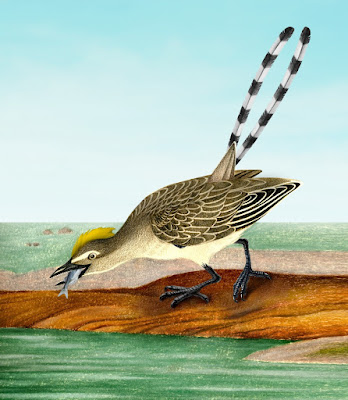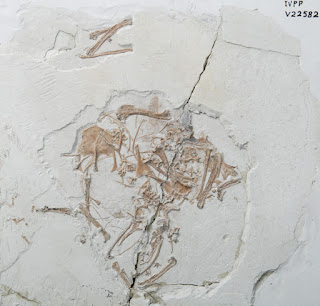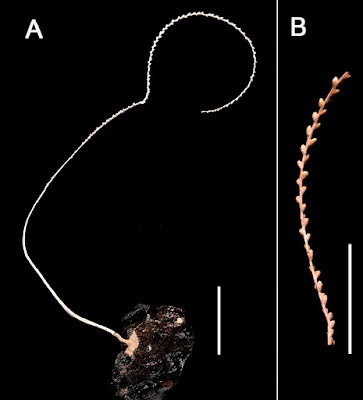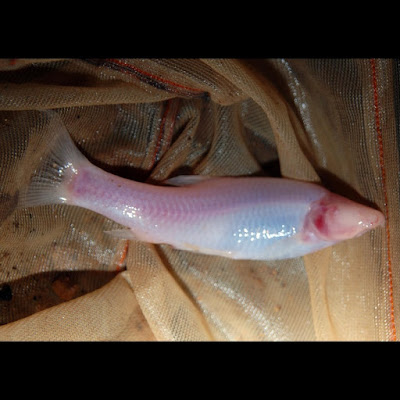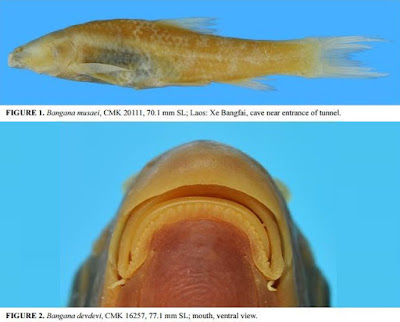[Most Recent Entries] [Calendar View]
Thursday, April 20th, 2017
| Time | Event | ||||||||
| 9:53a | [PaleoOrnithology • 2017] Piscivorenantiornis inusitatus • The First Known Piscivorous Enantiornithine Bird from the Early Cretaceous of China
ABSTRACT A fish-eating enantiornithine bird with a gastric pellet composed of fish bones has recently been reported from the Lower Cretaceous Jiufotang Formation of Liaoning Province, northeastern China. Along with other discoveries, this specimen reveals that distinct features of modern avian digestive system were well established in those early birds. On the basis of a detailed anatomical study presented here, we show that this fish-eating enantiornithine bird represents a new taxon, Piscivorenantiornis inusitatus, gen. et sp. nov. The well-preserved elements of the skull, neck, sternum, and pelvis further enrich our understanding of the morphological diversity in early enantiornithines. Most notably, the cranial articular facet of the caudal cervical vertebra is dorsoventrally concave and mediolaterally convex, a feature otherwise unknown among other birds and with unclear functional significance.
SYSTEMATIC PALEONTOLOGY AVES Linnaeus, 1758 ORNITHOTHORACES Chiappe, 1995 ENANTIORNITHINES Walker, 1981 PISCIVORENANTIORNIS, gen. nov. Type Species:— Piscivorenantiornis inusitatus, sp. nov. Etymology:— The generic name is derived from Latin ‘pisci’ and ‘vor,’ intended to convey ‘a fish-eating enantiornithine bird.’ PISCIVORENANTIORNIS INUSITATUS, sp. nov. Etymology:— The specific name is from Latin ‘inusitatus,’ referring to the unusual cranial articular facet of the caudal cervical vertebra.
Min Wang and Zhonghe Zhou. 2017. A Morphological Study of the First Known Piscivorous Enantiornithine Bird from the Early Cretaceous of China. Journal of Vertebrate Paleontology. DOI: 10.1080/02724634.2017.1278702 Min Wang, Zhonghe Zhou and Corwin Sullivan. 2016. A Fish-Eating Enantiornithine Bird from the Early Cretaceous of China Provides Evidence of Modern Avian Digestive Features. Current Biology. 26; 1170–1176. DOI: 10.1016/j.cub.2016.02.055 Fish-eating enantiornithine bird provides evidence of modern avian digestive features http://phy.so/381743208 via @physorg_com World's oldest bird vomit heaved out in China https://www.earthtouchnews.com/discoveri | ||||||||
| 2:46p | [Cnidaria • 2017] Flagelligorgia gracilis • A New Genus and Species of Golden Coral (Anthozoa, Octocorallia, Chrysogorgiidae) from the Northwest Atlantic Abstract A new genus and species of unbranched golden coral, Flagelligorgia gracilis, is described based on several specimens collected off the southeastern coast of the United States. The genus is provisionally included in the family Chrysogorgiidae, pending molecular confirmation. Flagelligorgia morphologically resembles other unbranched chrysogorgiids, such as Distichogorgia, Chalcogorgia, Helicogorgia and Radicipes, to which it is compared. The type species is illustrated and its distribution mapped. Keywords: Flagelligorgia gracilis, unbranched octocoral, biserial polyp arrangement, Radicipes, southeastern USA Taxonomy Subclass Octocorallia Haeckel, 1866Order Alcyonacea Lamouroux, 1812 Suborder Calcaxonia Grasshoff, 1999 Family Chrysogorgiidae Verrill, 1883 Type genus: Chrysogorgia Duchassaing & Michelotti, 1864. Diagnosis: (after Cairns (2001) and Pante et al. (2012)). Calcaxonians having an unjointed, solid (non-spicular), concentrically layered scleroproteinous axis. The axial layers are usually smooth (not undulated) and thus not longitudinally grooved externally; the axis usually displays metallic or iridescent reflections. The colony may be branched or unbranched (flagelliform), arising from a root-like or discoidal, strongly calcified holdfast. Polyps are contractile but not retractile, arranged in rows (uniserial, biserial or multiserial), but never in whorls. Sclerites predominantly flat, smooth scales, in some species warty rods and spindles. Flagelligorgia gen. n. Type species: Flagelligorgia gracilis, here designated. Gender: feminine. Diagnosis: Colonies unbranched (flagelliform), loosely coiled, attached by a holdfast; axis composed of undulating concentric layers (Figs 1C–E, 2D). Polyps arranged biserially. Body wall and coenenchymal scales elongate, smooth scales. Polyps lack an operculum. Distribution: Off Southeastern United States from North Carolina to Florida, 196–567 m depths. Etymology: The name is a combination of flagellum (Latin for small whip) and gorgia (a common octocoral suffix and once the name of the order Gorgonacea, the name derived from the mythical female monster, the Gorgon), in reference to the flagelliform nature of the colony. Flagelligorgia gracilis sp. n. Distribution: Southeastern coast of United States from off Outer Banks, North Carolina to off Carysfort Reef (near Key Largo, Florida) (Fig. 4), 196–567 m depths. Etymology: Named gracilis (Latin for slender, gracile), in allusion to the very slender aspect of the colony. Stephen D. Cairns and Ralf T. S. Cordeiro. 2017. A New Genus and Species of Golden Coral (Anthozoa, Octocorallia, Chrysogorgiidae) from the Northwest Atlantic. ZooKeys. 668: 1-10. DOI: 10.3897/zookeys.668.12203 | ||||||||
| 3:10p | [Ichthyology • 2017] Speolabeo, A New Genus Name for the Cave Fish Bangana musaei (Teleostei: Cyprinidae) from central Laos
Abstract Speolabeo, new genus, is established for Bangana musaei, a fish from caves in the Khammouan Karst in Laos. It was originally tentatively placed in the genus Bangana s.l. Besides characters related to hypogean life (absence of eyes, absence of pigment resulting in a whitish body), it is distinguished from all species of Bangana s.l. in having only 7–8½ branched dorsal-fin rays, the pelvic-fin at the vertical between the first unbranched and first branched dorsal-fin rays, and details of mouth morphology. Keywords: Pisces, cave fish, Laos, karst, Bangana, Altigena, Labeonini Maurice Kottelat. 2017. Speolabeo, A New Genus Name for the Cave fish Bangana musaei (Teleostei: Cyprinidae). Zootaxa. 4254(4); 493–499. DOI: 10.11646/zootaxa.4254.4.6 Maurice Kottelat and Helmut Steiner. 2011. Bangana musaei, a new cave fish from central Laos (Teleostei: Cyprinidae). Ichthyological Exploration of Freshwaters. 21(4); 313-322. http://pfeil-verlag.de/wp-content/upload [2011] Bangana musaei, new species, is described from caves in the Xe Bangfai drainage (a tributary of the Mekong) in central Laos. It is distinguished from all other species of the genus Bangana by its whitish body and absence of eyes. Incisilabeo (type species Labeo behri) is revalidated. |
| << Previous Day |
2017/04/20 [Calendar] |
Next Day >> |
